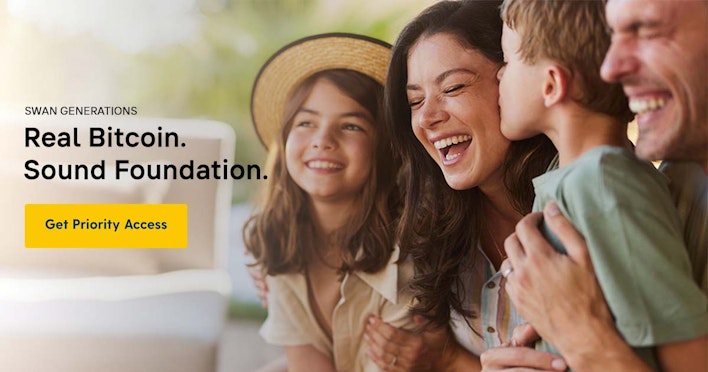

Introducing Swan Generations, Allowing Families to Allocate Real Bitcoin to the Next Generation
Swan Generations provides a unique service for parents, legal guardians, and others to make irrevocable gifts of real Bitcoin.
NFTs are a hot topic. They’re marketed as ownership, usually of some digital artwork, secured using “blockchain technology” and “crypto.”
The acronym NFT actually stands for “Non-Fungible Token.” That’s a real mouthful though, and most people don’t know what fungible even means. And, if people were told they were buying a token instead of an artwork, they might get confused, or rather, not get confused in the first place, and not buy the thing.
But here we are, with people buying NFTs for all kinds of money, mostly in the hopes of making more money by selling them for more money to someone else at some point in the future.
Buy automatically every day, week, or month, starting with as little as $10.
And here we come to the main problem. Most of those people are not going to make money. They’re going to lose money. They’re going to lose most of it, if not all of it.
Here’s the biggest reasons why.
What is ownership? It’s the right to determine how a thing is used.
In the case of an original oil painting, the thing exists in only one place at a time and the owner gets to decide where that place is — whether it’s in a vault, hanging on a wall in their home, or on loan to a museum. They can even choose to burn it if they want. And, finally, it’s the right to transfer that ownership to someone else by selling the thing to someone else.
However, this is not the case with any digital file — like a jpeg, gif, mp3, mp4 or any kind of digital file.
Digital files are not one-of-a-kind like oil paintings, or scarce like limited edition prints. A digital file can essentially be copied, perfectly and indistinguishably from a previous copy of the file, for essentially no cost. Files are just information and computers are information copying machines.
Presented with two identical digital copies of the same jpeg, there is no way to tell which is the original and which is a copy — they are identical, bit for bit, byte for byte.
Anyone can mint any number of these NFTs. They always start with an initial “minting” of 10,000 editions. But, the founders of these projects inevitably seek additional marketing ammunition. Take BAYC for example: They have nearly tripled their original drop due to the countless variations of NFTs based on the original releases. Finally, numerous other project founders looking for a quick buck make carbon copies of popular NFT projects which leaves them indistinguishable in appearance from originals.
These often sit on centralized platforms created on centralized protocols, suffering outages and will go away if any of the dependent layers go away, which they easily can. These are collectibles whose ownership records can vanish when the excitement for them wanes.
Collectible fads come and go: Beanie babies, cabbage patch kids, tomagochis. You may not even have heard of these, but they once had liquid markets desperate to collect them. They were simple and cheap to create and had big marketing budgets. But then interest waned and people forgot about them and the value plunged. Do you think people are going to be excited about digital rocks, apes or cats for the ages?
Investing in expensive collectibles is a very high risk undertaking. NFTs don’t even offer the guarantee of exclusive control over the collectible itself. And these are not genuinely rare, nor particularly good collectibles.
You can’t actually own and fully control a digital file. There is zero scarcity, so your NFT properties can be reproduced an infinite number of time. You are constantly exposed to an increasing number of platforms coming under scrutiny due to their unregistered security status. History shows us that actual art stands the test of time, and not collectible fads that go through a boom and bust cycle in such a short period of time.
The only investable digital asset is Bitcoin. It is scarce, divisible, verifiable, portable and censorship resistant. In 2022, when many of our assets and freedoms have come under attack, it is both the safest asset with the most exposure to upside in a generation.
Buy automatically every day, week, or month, starting with as little as $10.
Nick Payton is the Director of Marketing at Swan Bitcoin. He has operated his own consulting agency for over 10 years with a focus on digital campaigns for Fortune 500 companies. Nick’s analysis is shared across social media and native content on Swan.com. He is focused on educating people on the benefits of adopting Bitcoin.
News
More NewsThoughts on Bitcoin from the Swan team and friends.
By Jeremy Showalter
Swan Generations provides a unique service for parents, legal guardians, and others to make irrevocable gifts of real Bitcoin.
By Alec Bakouche
Rolling your old 401(k) into a Swan Bitcoin IRA lets you move legacy retirement savings into real Bitcoin while preserving tax advantages and compliance protections.
By Brady Swenson
Live human verification for every Bitcoin and USD withdrawal, creating a final checkpoint that blocks SIM swaps, device theft, and social engineering.
Audio narration